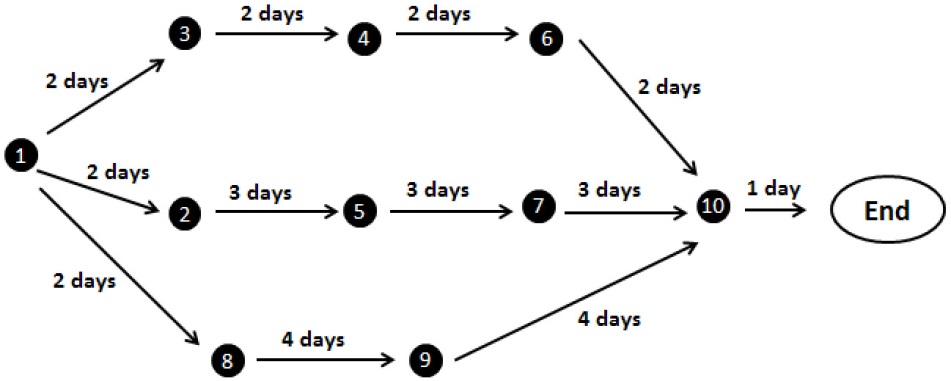One of the fundamental approaches to project scheduling is the Critical Path Method (CPM). In order to use the CPM, project managers need to understand what the critical path is and how to calculate it.
What Is the Critical Path?
The critical path is the longest path through the network based on task duration. This measures the shortest amount of time in which the project can be completed. Tasks not on the critical path have slack, while tasks on the critical path have zero slack. Slack is the amount of time that a task can be delayed without impacting the project end date.
A project activity network looks like this:
How Do You Calculate the Critical Path?
There are plenty of tools that can calculate the critical path for you. But even when using software, it’s helpful to know how it is calculate and understand what factors will affect it.
Calculating the critical path requires some assumptions and estimation. Some of the key assumptions include:
◆ All tasks are known: If you forget to add some tasks and add them later, the original critical path may change. Most project plans are missing tasks when they are initially built.
◆ All links are accurate: A complicated plan with hundreds of tasks is likely to have some incorrect task dependencies defined.
◆ All estimates are accurate: Inaccurate estimates can cause the original critical path to change.
◆ Other non-critical paths may have small amounts of slack: A complicated activity path can have multiple noncritical paths. A change in any one of these paths can cause the original critical path to change.
Given the amount of assumptions we rely on in our analysis, the only time you know the actual critical path is after project completion.
Despite these potential problems, the critical path method gives the project manager a good indication of where to focus attention. The most important application of CPM is to realize a late task on the critical path will cause the project end date to change.
The following shows an example of calculating the critical path.
|
Path |
Length of Path |
Longest? |
|
1-3-4-6-10 |
9 days |
No |
|
1-2-5-7-10* |
12 days |
Yes* |
|
1-8-9-10 |
11 days |
No |
Note that tasks 3, 4, or 6 can be up to 3 days late without changing the critical path. These tasks each have three days of slack.
Also note that the tasks on the 1-2-5-7-10 path are on the critical path and have zero days of slack. If any task on the critical path is late, the project end date will be later.
◆ What would happen if Task 2 consumed five days instead of three days?
◆ What would the length of the 1-2-5-7-10 path become?
◆In this case would the 1-2-5-7-10 path still be critical?
Further Reading
For a comprehensive guide on the Critical Path Method, we recommend ProjectManager.com’s article.
If you’d like additional information on effective project management practices or to learn more about what WiserWulff can do for your operations, please let us know. We can sit down with you to discuss your options and find a solution perfectly suited to your organization.



